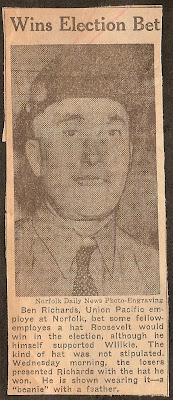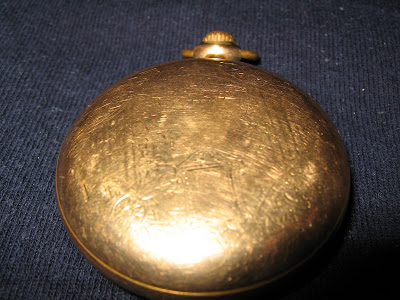Location:
Currently wrapped in paper towels and a Ziplock bag, this UFO is nestled in the bottom of a plastic food container. This shiny UFO has a plethora of things to tell besides the time. In years past, this likely resided in the vest pocket (or overall pocket) of a railroad employee by the name of Benjamin Richard.

Description:
Gold in color, this round watch shows signs of use and possibly abuse. The front glass/plastic cover is intact but needs cleaning. The hours are marked in clear, bold, black numbers with the minutes marked in red to the outside of the hours. The hour numbers all face in one direction (up-with the winder being the top) while the minutes are all facing the center of the watch face. Where hour number 6 should be is a second dial for seconds. These face the same direction as the hour numbers.
The hour and minute hands are black, shiny, and shaped like the spade in a deck of cards at the end. The hand for seconds is straight.
Both hour and second faces are white with black hashes for the seconds, minutes, and hours. Just above the number 7 hour, a small piece of the enamel has broken off. Near the 11 hour mark, there is a crack that splits to either side of the 56 minute mark. The face is double sunk, meaning the hour/minute dial is sunk and the second dial is sunk separately.
The front cover is removed by unscrewing it counter-clockwise. Under the cover is a single string of numbers, 9753341.
The rear of the watch has an undetermined pattern engraved on it. It appears to contain flowers and is geometric in nature.
The rear cover is removed by unscrewing it counter-clockwise as well. On the reverse of the cover are several markings and numbers. The inner workings also have several numbers and letters.
This watch does work but the UFO Team has been hesitant to wind it for any extended period of time. One minor twist did produce enough to prove it works.
Unique Marks:
Under the front cover, on the watch (but not the cover) - 9753341 - located between 5 and 6 hour marks.
Under the back cover, on the reverse of the cover (from top to bottom) - Keystone Watchcase, [a keystone symbol], [a scale symbol], J. Boss, 10K gold filled, 1644-J*, 9744616, 4883[reverse J]*, 12V3X423 [located to the right of center] - *Hand engraved numbers
Under the back cover, on the inner workings - B. W. Raymond, Elgin, Ill. U. S. A., 11628652, Safety Barrel, 19 Jewels, Adjusted
History:
Benjamin Richard was an employee of the Union Pacific Railroad Company for many years. This particular watch was produced in 1904 and is considered a Grade 240. Grade 240 was also known as the Veritas BWR (for Benjamin Wright Raymond, the first president of the Elgin National Watch Company). Technical specifications are as follows (Those more technically inclined can view the same information here.):
- Model 8
- Class 91
- double sunk open face
- stem wound
- lever set
- Size 18
- 3/4 plate
- nickel finish with damaskeening
- 19 jewels
- adjusted to 5 positions
- 5 beats per second
- railroad grade
After Benjamin Richard, the next likely owner was his son, Claud. From there, the ownership becomes as muddled and hard to read as the dirt and grime from years of history coat the watch face with mystery and dull the hands of time.
Photos:













Video:
References:
- Copious amounts of information retrieved from http://elginwatches.org/index.html
Special Thanks:
- Special thanks to Kurt R. A. Giambastiani. This private hobbyist and watch uber-enthusiast is also known for his popular Fallen Cloud saga books and for being an all-around great guy.








